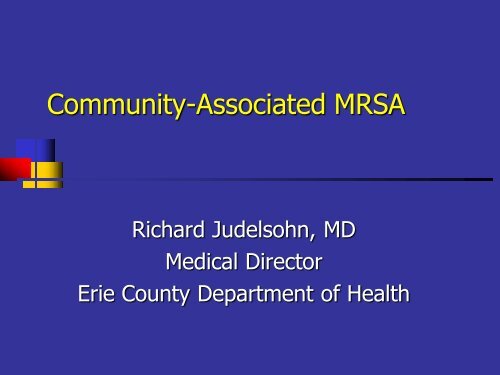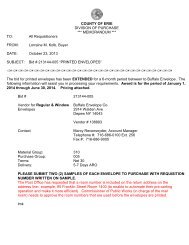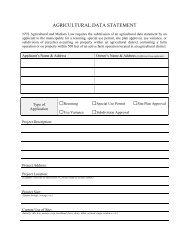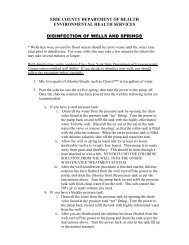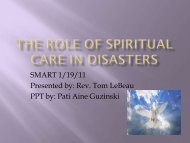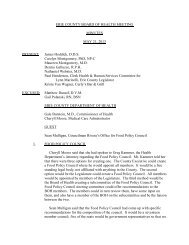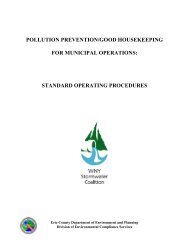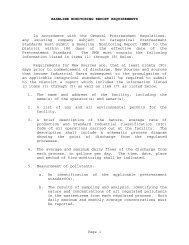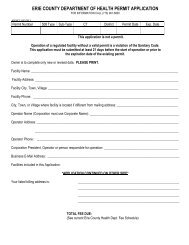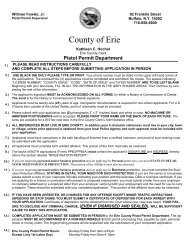Community-Acquired MRSA - Erie County
Community-Acquired MRSA - Erie County
Community-Acquired MRSA - Erie County
- No tags were found...
You also want an ePaper? Increase the reach of your titles
YUMPU automatically turns print PDFs into web optimized ePapers that Google loves.
Objectives• Define the CA-<strong>MRSA</strong> problem• Describe CA-<strong>MRSA</strong> clinical features• Present recommended CA-<strong>MRSA</strong> management• Discuss strategies to prevent spread andcontrol outbreaks
What is CA-<strong>MRSA</strong>?• <strong>Community</strong> <strong>Acquired</strong>, Methicillin-Resistant Staph Aureus• A type of Staphylococcus aureus bacteria• Resistant to some antibiotics• Treatable with other antibiotics
Where is CA-<strong>MRSA</strong> found?• Staph commonly found in our environmentand on the surface of our skin• People can “carry” Staph bacteria in theirbodies, especially their noses, without beingsick• 30% of people are carriers of Staph• 1% of people are carriers of <strong>MRSA</strong>
Clinical Presentation
How is CA-<strong>MRSA</strong> Transmitted?• Direct skin-to-skin contact• Contact with soiled bandages, wound drainage• Sharing personal items• Linens, towels, razors, bars of soap, clothing• Athletic equipment (e.g. weight benches)• Warm, moist environment• Athletes with cuts, scratches• More common in some settings (e.g. households,dorms, sports’ teams, daycare)
I think I have <strong>MRSA</strong>, whatshould I do?Seek medical attention• Incision and drainage to remove infected material• Lab tests to identify the bacteria• Treatment with appropriate antibiotics (e.g. Bactrim)• Proper wound care at home: cover your wound with cleandry bandages. Pus from infected wounds can contain <strong>MRSA</strong>,so keeping the infection covered will help prevent its spread• If multiple household members are infected, or repeatinfection in the same person, doctor may treat with nasalantibiotic ointment (e.g. Bactroban)
Treatment• Idea is to treat infection and clearpeople of colonization to preventrecurrence when indicated• May not be possible; the epidemiologyof respiratory (not skin-to-skin)transmission is under investigation
Other Measures• Improved hygiene• Antibacterial soaps• No sharing of bathroom items• Bathroom/house cleaning• Clean well-trimmed fingernails
I heard that there is a case of <strong>MRSA</strong> inmy school/workplace……• Risk of transmission in class/at work is low• Exclusion of infected students or staff is notnecessary, unless:• Doctor recommends exclusion• Draining, infected wounds cannot be covered• Should exclude infected persons from contact sports,swimming
I heard that there is a case of <strong>MRSA</strong>in my school/workplace……• Notification of parents and staff isdiscretionary• should be based on existing policy forother illnesses• Clusters of related cases should bereported to health department
ECDOH Guidelines for PreventingCA-<strong>MRSA</strong> Transmission in Schools• Good hand hygiene is the mosteffective prevention strategy• Wash hands frequently with non-bar soap.• Ensure access to sinks, soaps, and cleantowels.• Use liquid hand sanitizers when soap andwater are not available or as an addition toexisting hand hygiene regimens
ECDOH Guidelines for PreventingCA-<strong>MRSA</strong> Transmission in Sports’ Teams• Discourage sharing of personal itemssuch as towels, razors, lotions,deodorants, etc.• Regularly clean sinks, showers, andtoilets by saturating with disinfectant.• Disinfect athletic equipment betweenusers.
ECDOH Guidelines for PreventingCA-<strong>MRSA</strong> Transmission in Sports’ Teams• Wear gloves when handling dirtylaundry from sports related activities• Launder sheets, towels, sportsuniforms, and underclothing with hotwater and detergent• dry on the hottest setting
Disinfection• Follow New York State Office of GeneralServices (OGS) school green cleaningguidance for routine classroom and schoolbus cleaning using OGS-approved greencleaningproducts• Details available on OGS web site:http://www.ogs.state.ny.us/bldgadmin/environmental/default.html
Disinfection• Follow regular cleaning and maintenanceprocedures for equipment and materialsthat may be shared in the classroom suchas protective eyewear or clothing.• May also consider disinfectants on sharedenvironmental surfaces and equipment aspart of regular facility maintenance.
Management of <strong>MRSA</strong> in SchoolNYSED/NYSDOH• Classrooms and schools do not need to beclosed!!!!!!!!!• Students and staff with <strong>MRSA</strong> can attendschool regularly• if wound covered and receiving proper treatment• Students and staff should NOT be isolated orsent home for suspected <strong>MRSA</strong> infection.
Management of <strong>MRSA</strong> in SchoolNYSED/NYSDOH• Wash the area with soap and water and cover itlightly.• Those who touch the wound should wash their handsimmediately.• Student should be encouraged to have the woundexamined by healthcare provider as soon as possibleto confirm <strong>MRSA</strong> infection and determine treatment.• Wound should be kept lightly covered until it hasdried completely.• Disinfection indicated only for surfaces and objectsthat have been exposed to wound drainage
Management of <strong>MRSA</strong> in SchoolNYSED/NYSDOHFor more information, go to:NYS State Education Department andDepartment of Health:HEALTH ADVISORY: PREVENTION OFMETHICILLIN-RESISTANT STAPHYLOCOCCUSAUREUS (<strong>MRSA</strong>) INFECTIONS IN THESCHOOL SETTING October 25, 2007
HEALTH ADVISORY: PREVENTION OF METHICILLIN-RESISTANTSTAPHYLOCOCCUS AUREUS (<strong>MRSA</strong>) INFECTIONS IN THE SCHOOLSETTING October 25, 2007Unless directed by a physician, students with <strong>MRSA</strong> infections should notbe excluded from attending school. According to NYSEDCommissioner’sRegulations [8 NYCRR 136.3 (h)], schools may only exclude thosestudents with communicable diseases which are reportable underPublic Health Law. A list of such diseases may be found at 10NYCRR.2.1.Individual cases of <strong>MRSA</strong> infection are not reportable in New York State.Students with any open or draining wounds, such as <strong>MRSA</strong> infections,should be excluded from swimming pools, whirlpools, hot tubs, etc.until the wound has healed.NYS State Education Department and Department of Health: HEALTH ADVISORY: PREVENTION OF METHICILLIN-RESISTANT STAPHYLOCOCCUSAUREUS (<strong>MRSA</strong>) INFECTIONS IN THE SCHOOL SETTING October 25, 2007
Considerations for Students withImmune Suppression (e.g., HIV)• Students with weakened immune systems maybe at risk for more severe illness with <strong>MRSA</strong>.• These students should follow the sameprevention measures• should also contact their healthcare provider withany specific concerns.• Schools should maintain the student’s right toprivacy and confidentiality with this or anyhealth issue.
What The <strong>Erie</strong> <strong>County</strong>Department of Health is DoingGuidelines for schools, workplaces, the publicEstablishing surveillance for <strong>MRSA</strong> infections<strong>MRSA</strong> Info Hotline 858-2929Website information and links at:www.erie.gov/health/mrsa.asp
For more information, please go to these websites:<strong>Erie</strong> <strong>County</strong> Department of Healthhttp://www.erie.gov/health/mrsa.asp(This site has links to many other sites)You may also call (716) 858-2929 for <strong>MRSA</strong> information<strong>MRSA</strong> Toolkit for Schoolshttp://www.tpchd.org/page.php?id=364Questions and Answers about <strong>MRSA</strong>for School Health Professionalshttp://www.mass.gov/dph/cdc/antibiotic/mrsa_school_health.htmWindow/Mirror Clingssend request to cmt04@health.state.ny.us


